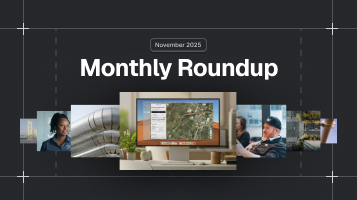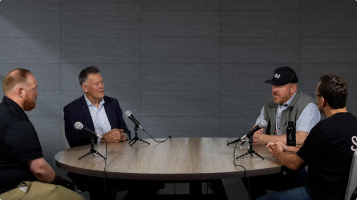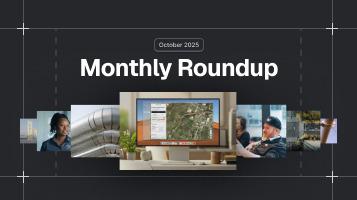Webinar Recap: Pursue Smarter, Bid Faster with 4M
Written by
.avif)
Chris Garafola
Published on
April 2, 2025
.avif)

Table of contents
The macro forces facing the AEC industry right now are putting project owners and civil engineering teams under immense pressure. Budgets are tight. Timelines are compressed. Projects are increasingly complex.
But at the same time, demand for infrastructure in the US is at an all-time high, thanks to the funding from the Inflation Reduction Act and the bipartisan infrastructure law. That’s exciting—but due to the capacity gap in skilled labor, it also means we must rethink how we plan, design, and pursue this work.

This gap is worsened by reliance on outdated methods like manual utility research. Every project that enters construction has to coordinate with, on average, 6.3 utility owners, with 265 million utility lines nationwide that require identification and validation. And since manual research is so time-consuming, 66% of those lines won’t get located on time before the construction phase begins. That missing research means projects get delayed and run over budget all too often. 4M CEO Itzik Malka expands on these challenges and how outdated proccesses affect project pursuits in his LinkedIn post below.
Fortunately, there’s a solution in sight. Digitization, using modern AI-driven workflows, will help the construction industry to meet today’s demand and stay ahead of tomorrow’s challenges with smarter, faster, safer infrastructure.
4M recently hosted a webinar on these challenges when it comes to project pursuits and opportunities with Randell Iwasaki, President and CEO of Iwasaki Consulting and former Director of Transportation at Caltrans: here are the key takeaways from this insightful conversation.
Construction Challenges: Utility Data and Cost Calculations
Randy led Caltrans for more than 6 years, so he saw first-hand how digitization changed the way big projects were run. In the 1980s, he recalls going out to the trailer with his colleagues and pulling out the utility info on sheets and sheets of paper to determine who owned them and who had to move them. It was slow going.
The goal at Caltrans and similar agencies was basically to get a project programmed, not to get a project programmed at the right amount. And they worried about the cost later. But the state legislature started to get more critical about blown budgets and hold them to the estimated amount, and they needed a more exact approach.
Randy: “So there was the old saying, you've got known knowns, you've got known unknowns, and you've got unknown unknowns. And those unknown unknowns are what worries you. The known unknowns that you should have known, but you don't know, those are the ones that when you get in front of your commission or your board and they're asking you and grilling you, why didn't you know this? Well, I should have known it because there are known unknowns, but I should have known it. Those are hard situations to be in. And so I think spending more time in the planning process gets you better construction down the road.”
Digitizing Utility Mapping and Understanding Risks
The process of uncovering those known unknowns has become more digital—in fact, Randy as the director of Caltrans led their digitalization transition—but he found that the utility mapping process was still slow going, even more than he expected. [Learn how Caltrans cut record research time by 95% with 4M.]
This utility mapping process is even more critical on the most complex projects, like a massive bridge, tunnel, or highway project that runs into the billions in costs, with contingencies built in for 10-15% of those costs.
Complexity goes beyond budgets, though.
Randy: Let's say you have an environmental work window. You can't go in during certain times because you've got a burrowing owl or you've got a nesting seagull or whatever you got. Well, it's important that you coordinate all this. And then if you're doing precast, like precast girders, once you get in line, you don't wanna get out of line because if you get out of line, they only produce so many precast girders and then you've got to step back in line and go back through that process. Now you're down the road, six, eight, 10 months. So all this stuff has to be coordinated, including the utility relocation is very, very critical. And the more complex the project, the more critical that utility relocation or utility coordination becomes.”
Knowing about as many of these factors ahead of time is critical for completing projects on time and on budget. But all that research, across all those factors and owners and the right of way, when there’s a tight RFP deadline looming, is really difficult and can feel like trying to get a crystal ball to predict the future.
But with 4M Analytics’ utility AI mapping software, the whole process has done more than digitalize: it’s accelerated and gotten incredibly sophisticated. Thanks to the right data, synthesized in the right way, owners and civil engineering teams can now instantly access actionable insights from all of this once disparate utility data in one platform
Randy: “Utility location has always been an issue. And so to use big data for that, that’s interesting. You've got electricity, you've got water, you've got sewer. You got gas, gas, high pressure gas lines and things like that. From a contractor's perspective, you don't want to hit those hazardous utility lines. You want to avoid that at all costs. And as an owner, I don't want anybody hurt on one of our projects. And so I just thought, wow, they can do that very quickly in the planning phase, and you can start really narrowing down what you want to pothole or what you want to check. This is a great tool.”
From Paper to AI: Navigating Digital Transformation in Construction
Going from paper to digital utility mapping seems exciting (and it is) but there’s also often resistance and a learning curve because it’s adopting something new. This happens with almost any new technology—think about when mobile banking apps started to hit the market. Many people were concerned about if those apps were safe, if they were secure, and if they were really that much of an improvement over traditional banking. Now we can’t imagine our lives without them.
But that learning and adoption curve is real, even for the most top-notch technology.
Randy: “So your organization has to be ready to digitize the project delivery process. If they're not, it's not going to go well. It's kind of like going off paper spreadsheets to track your projects into a project management software. It takes training. It has to follow your workflow. If it doesn't follow your workflow, your staff gets upset and disrupts the project delivery process.”
Getting your organization ready for this transition with intention and a roadmap is essential. You can’t just dive in and expect everything to change overnight.
But fortunately, 4M’s new Utility Insights Dashboard is here to help. It’s more than a tool—it’s like a utility AI agent on your side, helping you identify potential risks with just a few clicks. Powered by 4M's GenAI Agent, it analyzes utility locations, ROW, parcel zoning, and crossings, flagging potential conflicts that teams can click on to diagnose directly on the map to explore key areas of concern.
Randy: “If you can mitigate risk earlier, it’s gonna be a lot less than it would be later on. In the whole process, as you go closer to construction it will cost a whole lot more than if you had caught it in the early phase. In the early planning phases, when you’re planning a budget, that’s when it’s most critical.”
Finding these risks in the beginning also helps you avoid friction between teams, which can arise when design comes back to construction after the budget process with additional changes based on new information on utility and object placement. When there’s more accuracy earlier in the project, both teams can work together as partners instead of adversaries. And that helps projects get finished faster.
Faster, cost-justified proposals that earn client trust
Speed matters when you’re responding to RFPs too. But often there’s a balancing act required between getting a proposal in on time while making sure it’s high-quality and accurate so client expectations are met, from start to finish.
With 4M’s utility AI tools, you can skip the manual records research and get instant, reliable utility data and actionable project insights. Plus, the Utility Insights tool will give you access to data around on-surface objects as well, so you can get a holistic view of all the factors that will affect your project bid and timeline. You’ll know in the pursuit and bidding phase what the risks of the project are so you can generate more realistic risk registers.
That reliable, upfront view of the risks of your project will not only let you bid with confidence and budget with foresight. They also help you deliver final projects to your clients within the expected timeline and budget, improving their trust in your company and giving you a competitive edge now and in the future.
4M’s utility AI isn’t designed to stamp anything or replace surveying. It’s an early-stage research tool and the important human elements will still matter. But it’s designed to help humans be more effective when it matters, and free up time spent on manual research to more value-added pursuits.
4M’s utility AI mapping eliminates up to 90% of manual utility research time, delivering instant, reliable utility data and actionable insights. It’s powered by our advanced AI and our proprietary data, and it accelerates your project planning. It’s time for a digital transformation in construction and civil engineering—and with 4M, your digital transformation can be fast and easy.
Get Instant, Reliable Utility Data Today
Schedule time with our experts to learn how 4M’s Utility AI platform saves you time, money, and headaches by replacing manual record research with instant, reliable utility data you can trust and verify—at every stage of planning, design, and pre-construction.. Book a demo today.
Recent blog posts

Our Newsletter
Join 7k infrastructure professionals
Get monthly insights on ways to build smarter, faster and safer with Utility AI.




